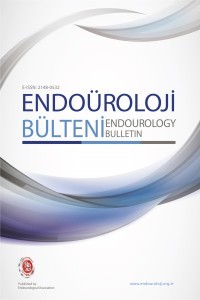Mini perkütan nefrolitotomi:yeni sistemlerin pratiğimize katkıları
Amaç: Bu çalışmada minimal invaziv perkütan nefrolitotomi (MIP) sistemi ile tedavi edilen böbrek taşı hastalarının değerlendirilmesi amaçlanmıştır. Gereç ve Yönlemler: Hastanemizde 2016-2017 yılları arasında MIP sistemi ile gerçekleştirilen ardışık 50 vakanın verileri retrospektif olarak değerlendirildi. Hastaların anestezi açısından risk değerlendirilmesi, hasta pozisyonu, giriş lokalizasyonu, taş boyutu, taşın temizlenme oranı, postoperatif drenaj ve komplikasyonlar değerlendirildi. Bulgular: Tüm hastalara mPNL prosedürü gerçekleştirildi. Ortalama taş boyutu 20 (12-33) mm ve ortalama taş sayısı 1 (1-3) idi. Ortalama taş temizlenme oranı %98 (97-100) idi. Komplikasyon oranı %6 ve transfüzyon ihtiyacı %2 idi. Sonuç: Komplikasyon oranının azlığı, tüm kalikslere daha rahat ulaşım ve farklı hasta pozisyon avantajları ile MİP sistemleri ile mini PNL, konvansiyonel PNL’nin yanısıra, üreterorenoskopi ve ESWL’ye iyi bir alternatif olabilir.
Anahtar Kelimeler:
miniPNL, PCNL, Perkütan Nefrolitotomi, MIS, Minimal İnvaziv
Mini percutaneus nephrolithotomy:the contrubition of the new system to our practice
Objective: In this study, the evaluation of the patients who were operated with Minimal Invasive Percutaneus Nephrolithotomy (MIP) approach is aimed. Material And Methods: The data of consecutive 50 mPNL patients between January 2016- January 2017 were obtained and retrospectively evaluated. All patients were evaluated in terms of anesthesiology risks, patient positions, access locations, stone sizes, stone clearence rates, postoperative drainage requirement and complications.Results: All patients have undergone mPNL procedures. Mean stone size was 20 (12-33) mm and mean stone number was 1 (1-3). Mean stone clearence rate was 98% (97-100). Complication rate was 6% while transfusion necessity was 2%. Conclusion: mPNL with MIP system, with its low complication rate, easy access to all calyceal systems and advantages of different patient posisitons, may be a good alternative to cPNL, even to ureterorenoscopy and ESWL.
Keywords:
Mini-PNL, PNL, Percutaneous nephrolithotomy, MIP, Minimally invasive,
___
- 1. D’Arcy FT, Lawrentschuk N, Manecksha RP, Webb DR. Renal track creation for percutaneous nephrolithotomy: the history and relevance of single stage dilation. Can J Urol 2015; 22: 7978–83
- 2. Webb DRTH. Intraluminal surgery of the uper tract. Dial Paed Urol 1995; 18: 2–4
- 3. Giusti G, Piccinelli A, Taverna G et al. Miniperc? No, thank you!. Eur Urol 2007; 51: 810–5
- 4. Nagele U, Horstmann M, Sievert KD et al. A newly designed amplatz sheath decreases intrapelvic irrigation pressure during mini-percutaneous nephrolitholapaxy: an in-vitro pressure-measurement and microscopic study. J Endourol 2007; 21: 1113–6
- 5. Nicklas AP, Schilling D, Bader MJ et al. The vacuum cleaner effect in minimally invasive percutaneous nephrolitholapaxy. World J Urol 2015; 33: 1847–53
- 6. D’Souza N, Paul S. Mini percutaneous nephrolithotomy for renal calculi in paediatric patients: a review of twenty cases. Urol Ann 2016; 8: 16–9
- 7. Schilling D, Gakis G, Walcher U, Stenzl A, Nagele U. The learning curve in minimally invasive percutaneous nephrolitholapaxy: a 1-year retrospective evaluation of a novice and an expert. World J Urol 2011; 29: 749–53
- 8. Long Q, Guo J, Xu Z et al. Experience of mini-percutaneous nephrolithotomy in the treatment of large impacted proximal ureteral stones. Urol Int 2013; 90: 384–8
- 9. Valdivia JG, Scarpa RM, Duvdevani M et al. Supine versus prone position during percutaneous nephrolithotomy: a report from the clinical research office of the endourological society percutaneous nephrolithotomy global study. J Endourol 2011; 25: 1619–25
- 10. Tefekli A, Ali Karadag M, Tepeler K et al. Classification of percutaneous nephrolithotomy complications using the modified clavien grading system: looking for a standard. Eur Urol 2008; 53: 184–90
- 11. Schilling D, Husch T, Bader M et al. Nomenclature in PCNL or The Tower Of Babel: a proposal for a uniform terminology. World J Urol 2015; 33: 1905–7
- 12. Jackman SV, Docimo SG, Cadeddu JA, Bishoff JT, Kavoussi LR, Jarrett TW. The “mini-perc” technique: a less invasive alternative to percutaneous nephrolithotomy. World J Urol 1998; 16: 371–4
- 13. Abdelhafez MF, Bedke J, Amend B et al. Minimally invasive percutaneous nephrolitholapaxy (PCNL) as an effective and safe procedure for large renal stones. BJU Int 2012; 110: E1022–6
- 14. Knoll T, Wezel F, Michel MS, Honeck P, Wendt-Nordahl G. Do patients benefit from miniaturized tubeless percutaneous nephrolithotomy? A comparative prospective study J Endourol 2010; 24: 1075–9
- 15. Cheng F, Yu W, Zhang X, Yang S, Xia Y, Ruan Y. Minimally invasive tract in percutaneous nephrolithotomy for renal stones. J Endourol 2010; 24: 1579–82
- 16. Lahme S, Bichler KH, Strohmaier WL, Gotz T. Minimally invasive PCNL in patients with renal pelvic and calyceal stones. Eur Urol 2001; 40: 619–24
- 17. Liu L, Zheng S, Xu Y, Wei Q. Systematic review and meta-analysis of percutaneous nephrolithotomy for patients in the supine versus prone position. J Endourol 2010; 24: 1941–6
- 18. Yuan D, Liu Y, Rao H et al. Supine Versus Prone Position in Percutaneous Nephrolithotomy for Kidney Calculi: a Meta-Analysis. J Endourol 2016; 30: 754–63
- 19. Bader MJ, Pongratz T, Khoder W et al. Impact of pulse duration on Ho: YAG laser lithotripsy: fragmentation and dusting performance. World J Urol 2015; 33: 471–7
- 20. Nagele U, Nicklas A. Vacuum cleaner effect, purging effect, active and passive wash out: a new terminology in hydrodynamic stone retrival is arising–Does it affect our endourologic routine? World J Urol 2016; 34: 143–4
- 21. Mager R, Balzereit C, Gust K et al. The hydrodynamic basis of the vacuum cleaner effect in continuous-flow PCNL instruments: an empiric approach and mathematical model. World J Urol 2016; 34: 717–24 22. Michel MS, Trojan L, Rassweiler JJ. Complications in percutaneous nephrolithotomy. Eur Urol 2007; 51: 899–906
- Yayın Aralığı: Yılda 3 Sayı
- Başlangıç: 2020
- Yayıncı: ENDOÜROLOJİ DERNEĞİ
Sayıdaki Diğer Makaleler
Mini perkütan nefrolitotomi:yeni sistemlerin pratiğimize katkıları
Yusuf İlker ÇÖMEZ, Doğukan SÖKMEN
Endoskopik üriner sistem taş tedavisi sonrası ürosepsis: riski artıran faktörler
Dilek BULUT, Merve Sefa SAYAR, Ender Cem BULUT, Alper BİTKİN, Fatih BIÇAKLIOĞLU, Serhat ÇETİN, Murat KOPARAL, Kasım ERTAŞ
Genç hastada mesane tümörü ve genetik alt yapı
Doğukan SÖKMEN, Yusuf İlker ÇÖMEZ, Volkan TUĞCU
Üst üriner sistem taşları tedavisinde retrograd intrarenal cerrahi deneyimlerimiz
